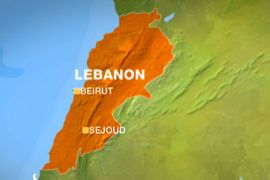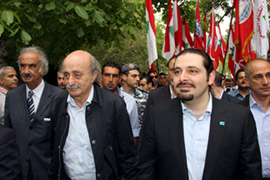Country profile: Lebanon
Lebanon is one of the most politically contested nations in the region.

 |
Lebanon is one of the smallest countries in the Middle East, yet it is one of the most politically contested nations in the region – largely owing to its proximity to Israel.
Countries such as Iran, Syria, and the United States have each sought to exert their influence over Lebanon, where political parties have received support from Tehran and Damascus or the West.
| In depth | ||
IN VIDEO INTERACT |
The Lebanese voted in a parliamentary election on June 7, 2009, just over a year after the country’s feuding political factions reached an agreement in Doha, the Qatari capital, on the formation of a new cabinet.
Prior to that deal, street battles between supporters of the Hezbollah-led March 8 movement and the Western-backed March 14 parliamentary bloc had raised the spectre of a return to civil war – 18 years after a bloody internecine conflict had ended.
The country is battling to rebuild after Israel launched a 34-day war in 2006 against Hezbollah, a Shia Muslim political party and armed resistance movement.
The war devastated swaths of southern Lebanon and the southern suburbs of Beirut, the capital.
The 1975-1990 civil war, Israel’s war on Lebanon in 2006 and continuing political tensions have all contributed to ending Beirut’s reign as the “Paris of the Middle East” – the capital was once the main financial hub of the region.
The tourism industry, a mainstay of the economy, has also been severely damaged as a result of the 2006 war and domestic political infighting.
Political infighting
The state of Greater Lebanon was established in 1920 after the League of Nations granted France a mandate for Lebanon and Syria.
Lebanon declared independence from France 21 years later. The country’s Sunni Muslim and Maronite Christian leadership reached agreement in 1943 on the National Pact, an unwritten deal which divided positions of power on a confessional basis, according to the 1932 census.
| Factfile | |
|
Source: CIA World Factbook – May 2009 |
Another 15 legally recognised ethnic and religious groups live in Lebanon, including Druze, Greek Orthodox and Alawi communities, making the country one of the most diverse in terms of religion and ethnicity in the Middle East.
More than half of the country’s four million population live in Beirut, the capital. While the capital is famous throughout the Middle East for its glamour, southern Lebanon is home to thousands of farmers.
Cereal, tobacco, fruit and vegetables are the main crops harvested during the hot and dry Mediterranean summers.
While GDP per capita is reasonably high, at $11,100 in 2008, Lebanon is facing a “brain drain”.
Thousands of professional Lebanese have sought work in the US and the Gulf, expressing little confidence in the political situation and stability.
Pledges totalling $7.5bn from international donors at the January 2007 Paris III conference increased confidence among the Lebanese that the country would be in a strong position to rebuild after the devastating 2006 war.
However, sectarian and political violence throughout 2007 and 2008 severely limited economic recovery.
The May 2008 Doha agreement between Lebanon’s feuding political parties has encouraged inward investment, but the global financial crisis could further arrest economic growth.
Political power in Lebanon has traditionally been concentrated among a few prominent families.
The Jumblatts are the leading political family in the Druze community, while the Gemayels are one of the most politically active Maronite families.
However, comparatively young political organisations such as Hezbollah have little dynastic tradition.
End of civil war
While the Taif Accord of 1989, which ended the civil war, re-distributed parliamentary seats evenly between Muslims and Christians, Lebanon has not held a census since 1932.
In the decades since that population survey the Shia Muslim community, concentrated in the south, has expanded at a faster rate than any other in Lebanon.
The Maronites, in particular, have little appetite for holding a new census as the results could show that they have slipped behind the Shia and Sunni communities in terms of population – and hence loosen their claim to the prestigious presidential post.
Most of the Shia community in Lebanon lends its support to Hezbollah, one of the country’s youngest political movements. The group formed in 1982 as an armed resistance movement against Israel’s military occupation of Lebanon (which was aimed at pushing Palestinian fighters out of Lebanon).
The group made its formal entry into the Lebanese political sphere in 1992, taking part in a general election.
Hezbollah, which has received funds and training from Iran, is also Syria’s biggest ally in Lebanon.
 |
| Jumblatt, centre, and Saad al-Hariri, right, son of former prime minister Rafiq al-Hariri [EPA] |
After the Lebanese civil war ended, Syrian troops and security remained in the country, backed up by the provisions of the Taif Accord.
But while the agreement expressly called for Damascus to pull its forces back to Lebanon’s Bekaa valley no more than two years after the ratification of the accord, Syrian troops and security agents were still in the country by early 2005.
Many Lebanese, particularly those from the Christian and Sunni communities, had accused Damascus of running an overlordship of Lebanon.
But what forced the end of Syria’s physical presence in Lebanon was not a slow-burning campaign but widespread public anger at the assassination in February 2005 of Rafiq al-Hariri, a former Lebanese prime minister and businessman. By April 2005, Syrian troops had left the country.
Two key dates in March 2005 have latterly been used to designate the political leanings of Lebanese parties in the post-Syrian era.
On March 8, thousands of people turned out in a Hezbollah-organised rally in southern Beirut to demonstrate support for Syria.
However, a much larger demonstration called by Sunni Muslims, Druze and Christian parties on March 14 demanded Syria’s exit from the country.
Lebanon’s political set-up remains fragile. While some parties within the March 14 bloc remain opposed to a peace deal with Israel, they were critical of what they called Hezbollah’s unilateral decision to launch a cross-border raid into Israel in July 2006, which led to Israel waging a war against Lebanon.
Hezbollah, which has consistently maintained that its armed wing’s actions against Israel are intended to act as a bulwark against any possibility of a new occupation by the Jewish state, has in turn accused March 14 of fostering ties with the West that are inimical to Lebanon’s Arab identity.

 The battle for votes
The battle for votes